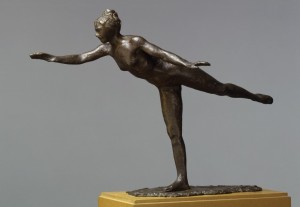Edgar Degas. Intimity and Pose / Hamburger Kunsthalle, Germany
Hamburger Kunsthalle
Edgar Degas. Intimity and Pose
Exhibition : 6 February > 3 May 2009
The central theme of Intimacy and Pose is Degas’ unique perspective on the female body. Unlike many of his contemporaries, Degas was not primarily interested in presenting staged poses in his sculptural work; he preferred to capture the posture and movements of women when they felt unobserved. His preoccupation with these private moments resulted in “intimate poses”: dancers rehearsing ballet positions, tying their shoes or examining their feet; women combing their hair or washing themselves.
Edgar Degas
Edgar Degas (1834-1917)
Vor dem Spiegel,um 1889
© Hamburger Kunsthalle / bpk
Photo: Elke Walford
In addition to his many well-known pastels and paintings, the French Impressionist Edgar Degas (1834–1917) also made numerous sculptures, but the large majority of these were never presented to the public. Shortly after his death, the figures of dancers, bathers and racehorses he had originally modelled in wax were secured, and in 1919 they were cast in bronze. The exhibition Intimacy and Pose presents the complete set of 73 original bronze casts. During his lifetime Degas only ever exhibited one of the wax sculptures – Petite Danseuse de Quatorze Ans (Little Dancer Aged Fourteen) – which caused a sensation at the Sixth Impressionist Exhibition in 1881 due to the remarkable naturalism of the figure.
Above all, Degas depicts women waiting off-stage and at their toilette. By focussing on the work they have to invest in their bodies before appearing in public, he draws our attention to the care and disciplined training of the body, but also to moments of relaxation. This unidealised view of the unadorned female body and its preparation – a highly unusual perspective at that time and one which occasionally shocked viewers and critics – is also addressed in the impressive selection of drawings, pastels and paintings on show here alongside the bronze sculptures.
Degas himself once remarked upon his depictions of women: “Hitherto the nude has always been represented in poses which presuppose an audience. But my women are simple, honest creatures who are concerned with nothing beyond their physical occupations. It is as if you were looking through a keyhole.” The intimacy of the moment in no way exposes the subjects, however. Degas’ detached view instead captures the distinctive expression of the poses. His eschewal of staged femininity in favour of the aesthetic quality of the sculpture or picture is revolutionary in its approach.
Edgar Degas
Edgar Degas
Vier Tänzerinnen auf der Bühne
um 1885-1890
Museu de Arte de São Paulo
© Luiz Hossaka
Edgar Degas
Große Arabeske, zweite Position
© Hamburger Kunsthalle/bpk
Photo: Elke Walford
Edgar Degas
Das Wannenbad ,
Pastell auf Karton, 60 x 83 cm
Musée d’Orsay, Paris
© bpk/RMN/Hervé Lewadowski
A comprehensive catalogue has been published to accompany the exhibition, available from the museum shop for EUR 35.
- © Hamburger Kunsthalle
© Images. All rights reserved
Links
Stampfli & Turci Art Dealers – Espaces Arts & Objets










[…] Edgar Degas. Intimity and Pose / Hamburger Kunsthalle, Germany […]
Edgar Degas. Intimität und Pose / Hamburger Kunsthalle « Espaces Arts & Objets said this on February 4, 2009 at 4:05 pm |
THE DEAD DON’T SCUPT
All so-called sculptures in bronze, attributed to Edgar Degas, are posthumous -counterfeits-.
You see, Edgar Degas was some three or more years dead (d. 1917) when those 2nd to 3rd-generation-removed counterfeits were posthumously reproduced in bronze with counterfeit -Degas- signatures applied between 1920 to 1936 or later.
The dead don’t sculpt, much less sign anything.
This factual perspective is confirmed in the National Gallery of Art’s published 1998 Degas at the Races catalogue. On page 180 in Daphne S. Barbour’s and Shelly G. Strum’s “The Horse in Wax and Bronze” essay, these authors write: “Degas never cast his sculpture in bronze, claiming that it was a “tremendous responsibility to leave anything behind in bronze — the medium is for eternity.”
Additionally, on the National Gallery of Art’s http://www.nga.gov/education/degas-11.htm website, it states: “By comparing the sculpture to stylistic changes in Degas’ paintings and pastels, we are developing a chronology for the sculpture, which Degas did not date or sign.”
In the United States the Association of Art Museum Directors endorses the College Art Association’s ethical guidelines on sculptural reproductions. In part, those ethical guidelines state: “any transfer into new material unless condone by the artist, is to be considered inauthentic or counterfeit and should not be acquired or exhibited as works of art.”
Finally, two more thoughts to consider: 1) Degas never worked exclusively in -wax-, therefore his work could not be directly reproduced into bronze and 2) the bronzes, falsely attributed to a dead guy, are 2nd to 3rd-generation-removed forgeries with the founder and his workers fingerprints on them, not Degas’.
To learn more, link to: http://garyarseneau.blogspot.com/2007/05/all-degas-bronze-sculptures-are-fake.html
Gary Arseneau
artist & scholar
Fernandina Beach, Florida
garyarseneau.blogspot.com